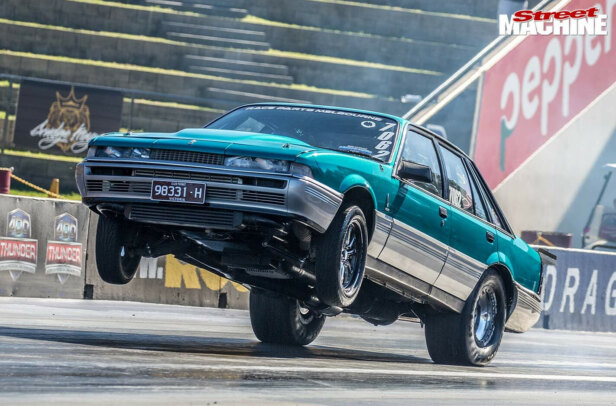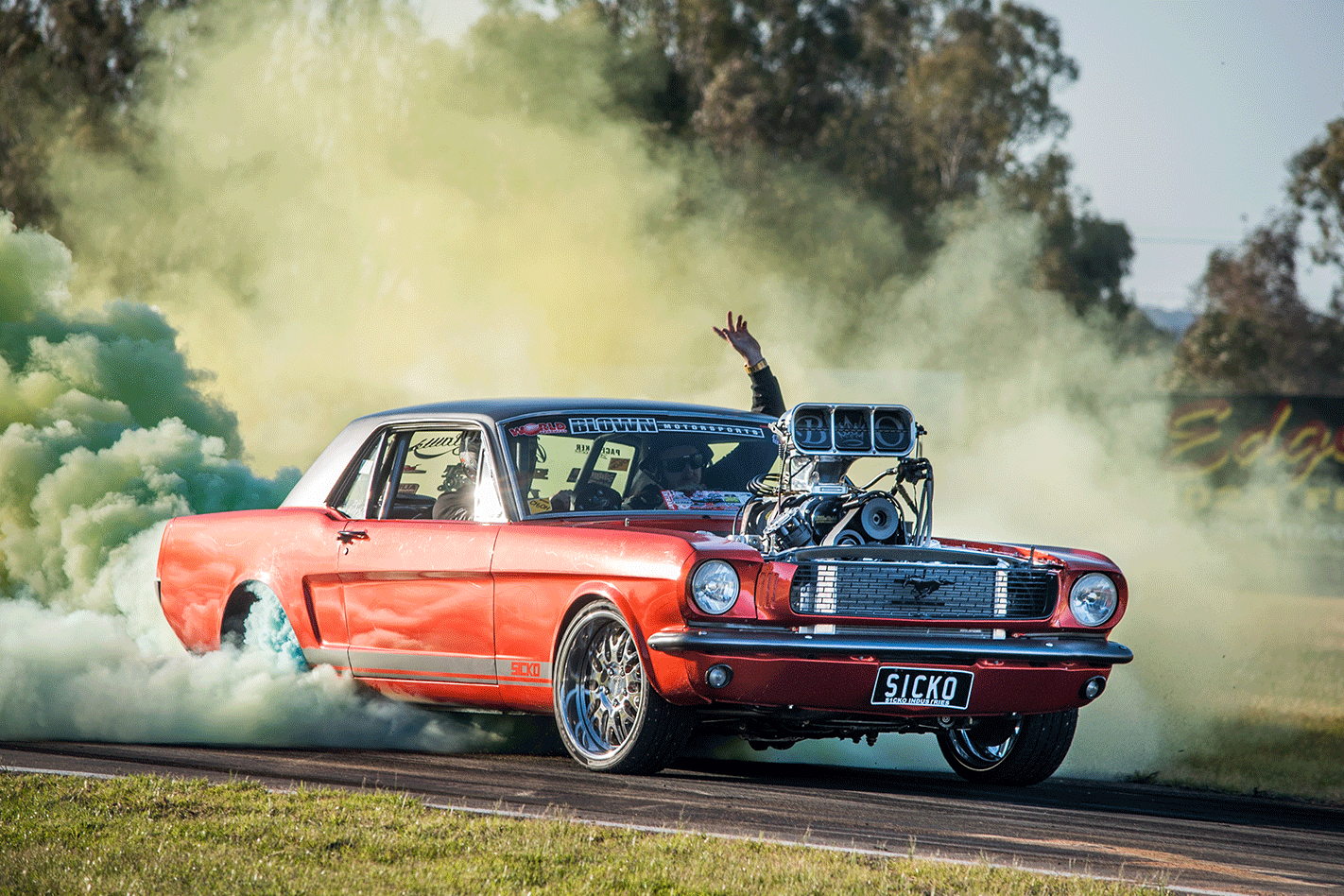When you’re talking about Australian Pro Mod turbo racing at its very best, Greg Tsakiridis’s car has to be in the conversation. The Tim McAmis-built Ford Mustang was pieced together with just one purpose: to dominate the turbo Pro Mod scene, initially in the USA and now here in Australia.
First published in the May 2022 issue of Street Machine
Loaded with 4500hp worth of twin-turbo, billet V8 badness and capable of 0-274mph in under six seconds, this thing is a thrill to watch, and you’d have to think it’s even more hair-raising from behind the wheel.
Initially built for the Moits Racing stable, the Mustang set a new world terminal speed record in 2015 when it recorded a [email protected] at the PSCA Street Car Super Nationals in St Louis.
Later, the Moits team brought the car to Australia, but it only raced half-a-dozen passes here before an impact with the wall. The team then moved on to building their new Doorslammer – another amazing car.
After racing a nitrous-huffing small-block Ford-powered RX-4 for most of his career in the APSA ranks, Greg Tsakiridis took over racing the ’Stang in 2018, winning Pro Extreme at his first event, Santo’s Summer Thunder.
“I always dreamed about racing Pro Mod,” Greg says. “I was wanting to get one built, and initially this car wasn’t for sale, but then I got the call: ‘Hey, here you go, you can buy this one if you like.’”
Under the full carbonfibre body is a 540ci Pro Line 481X with a pair of massive 102mm Precision turbos. The motor combines the best of a Hemi and a Chev, and was designed by Alan Johnson. Pro Line then took this package and developed it according to its own recipe.
When the car was still in the US, it was tuned by Pro Line’s Steve Petty, with Con Elfes from Sydney’s CV Performance making trips to the States whenever it was being campaigned. Now that the car is being run here in Oz, Con has taken on tuning duties.
While the Mustang remains mostly the same as when Moits owned it, Greg has made a number of refinements that allow him to run the car just as quickly without having to lean on it as hard. “‘Skip’ from the Moits race shop has remade the turbo manifolds, which made a big difference to the car,” Greg says. “We have made a lot of changes to the front end, especially in the struts and valving.”
The attention to detail and level of engineering is everything you would expect from a world-class performer.
The fuel system is impressive, with a front header tank feeding a Waterman Big Bertha mechanical fuel pump and 14 massive 700cc injectors via an Aeromotive rising-rate regulator.
The intake manifold is CNC-machined from billet, and with the improved hot side and changes to cam timing, Greg has been able to go quicker on less boost.
“Typically on a pass we leave the startline on 12psi, and within two seconds we have 55psi dialled in,” Greg says. “Depending on how fast we are trying to run, sometimes we will add another 3lb of boost, and from half-track onwards we can pick up another 30mph with the lock-up converter. The 2-3lb of extra boost will usually add an extra 7-10mph.
“We turn the engine to around 9500rpm, and the most exciting part of the run is the launch,” he continues. “Then when lock-up comes on, the car just slingshots forward, adding another 30mph to your terminal speed. The biggest g-force is not actually on the launch but when you pull the ’chutes at 270mph; it wants to pull you through the front windscreen.”
To date, Greg has run a best of 5.50@274mph, making the Mustang the quickest door car outside of the United States. “We are in the Top 10 quickest in the world [the quickest is 5.37], and we are within 1mph of the fastest in the world,” he says.
In race trim, the car weighs 2700lb and races in Pro Mod, a class with essentially no rules. Unlike some other race cars, Greg’s team can turn the Mustang around in just 40 minutes at the track, including cooling the tranny, running the rockers, banging in a new set of plugs, giving it a quick spanner check and a splash of fuel, and emptying the puke tanks.
In terms of off-track maintenance, the engine gets a new set of either GRP or BME conrods every 30-40 passes, depending how hard they are leaning on it. Big-ends and mains get checked every meeting, and this is where the team really assesses the tune-up based on the wear on the bearing shells. The crank comes out every 80 passes to be crack-tested, pistons are replaced every 130-150 runs, and there are receiver grooves in the sleeves and O-rings in the heads to seal the combustion charge. The heads come off every second meeting for a service, or when the rods are changed. The titanium valves are consumable items, but everything lives longer when the car is making 5.80sec passes than when it’s running 5.50s.
Fortunately, Greg can do the maintenance on the car himself with the help of his team, which brings the parts bill to around $3000 for 60 passes – pretty darn amazing.
Backing up the mega-mill is a Mark Micke three-speed TH400 and 12-inch converter.
The car originally started on a BigStuff ECU, but that was swapped out for a FuelTech item two years ago. The ’Stang is equipped with turbo speed, BOV timer and wastegate sensors, along with the usual sensors for fuel pressure, boost, TPS, EGTs, oil pressure and temperature, and driveshaft and wheel speed.
“Driveshaft speed is probably the most important sensor, as we know whether or not the car is hooked up,” says Greg. “We really only make changes to timing and don’t muck around with boost. When you make a boost change, you need to make a lot of other changes to the car; timing is simple in comparison.
“Now that the car is dialled in, if it goes straight, we don’t touch the Strange shocks in the front or Penske shocks in the rear.”
The car has now run a top speed of 274mph, and Greg reckons it’s time to start pushing it. “We want the number-one spot worldwide, and all we need is time and a good track,” he declares. “The car has plenty of power, and we think we will touch a 5.30 or a 5.40 for sure. We need to get to half-track quicker than our current 3.70 at 212mph.” Currently, Greg has run a best of .961 to the 60-foot, which must be one hell of a ride from the driver’s seat.
It’s a huge accomplishment to successfully campaign a car like this; fortunately, Greg gets plenty of support from family, friends and many great Australian businesses. One way or another, the best is yet to come for this Mustang.




Comments